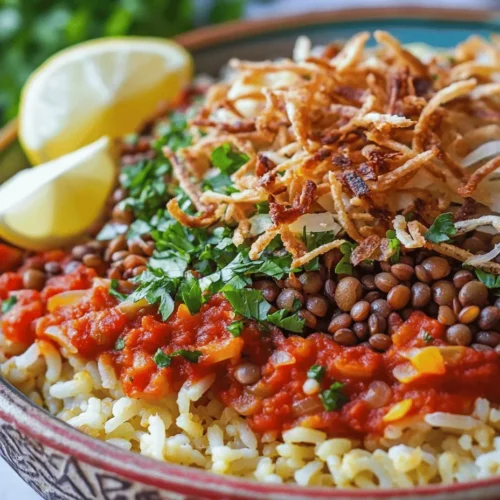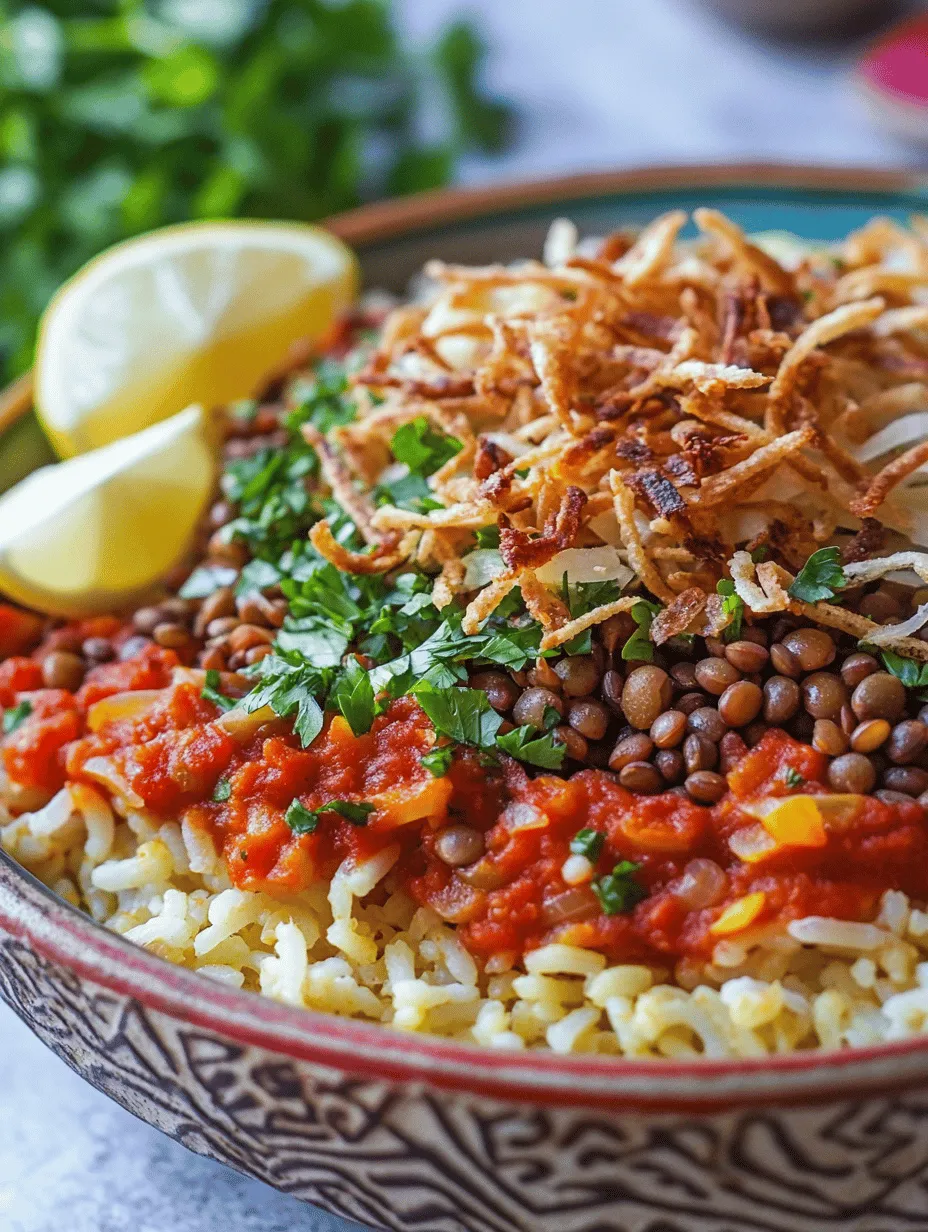Koshari is not just a dish; it’s a beloved symbol of Egyptian culture, representing a harmonious blend of flavors and textures that come together to create a satisfying meal. This hearty dish, often considered the national dish of Egypt, combines lentils, rice, and pasta with a rich tomato sauce, topped with crispy onions for that perfect crunch. In this article, we will delve into the rich history of Koshari, explore its ingredients, and provide a step-by-step guide to creating this delectable dish right in your kitchen.
The Rich History of Koshari
Understanding the origins of Koshari can enhance your appreciation for this dish.
The Cultural Significance of Koshari
Koshari has its roots deeply entrenched in Egyptian street food culture. It is believed to have been introduced during the 19th century, primarily as a filling meal for the working class. While the exact origins of Koshari are somewhat murky, it is widely acknowledged that its creation was influenced by a variety of cultures, most notably the Italian cuisine that made its way to Egypt during the 19th century. The introduction of pasta into the Egyptian culinary scene is said to have played a pivotal role in shaping Koshari as we know it today.
Originally, Koshari was a simple meal made with leftover ingredients, but over time it evolved into a beloved dish that can be found in homes, local eateries, and street vendors across Egypt. The dish exemplifies the resourcefulness of Egyptian cooks, showcasing how humble ingredients can be transformed into a delicious and fulfilling meal. Today, Koshari is celebrated not just for its taste but also for its ability to bring people together, reflecting the unity and community spirit that is central to Egyptian culture.
The Role of Koshari in Egyptian Society
Koshari serves as a symbol of unity in Egyptian society. It is often enjoyed during family gatherings, celebrations, and even during everyday meals, transcending social classes. Its affordability makes it accessible to everyone, from street vendors serving it to those on a budget to upscale restaurants offering gourmet versions.
During special occasions and holidays, Koshari takes on an even greater significance. Families often gather to prepare Koshari together, reinforcing bonds and sharing stories while cooking. The dish is not just food; it is a way of life, a celebration of heritage, and an expression of love and hospitality.
Ingredients Breakdown: The Heart of Koshari
To create a perfect Koshari, it’s essential to understand each ingredient’s role and significance. Here, we will explore the fundamental components that come together to make this iconic dish.
Lentils: The Nutritional Powerhouse
Lentils serve as the backbone of Koshari. They are not only a fantastic source of protein but also packed with fiber, iron, and essential vitamins. The most commonly used lentils in Koshari are the brown and green varieties, as they hold their shape well during cooking and provide a hearty texture.
Cooking Tips: To achieve the perfect texture, rinse the lentils thoroughly before cooking to remove any debris. Boil them in salted water until they are tender but not mushy, which usually takes about 15-20 minutes. Keep an eye on them to ensure they don’t overcook, as they are meant to retain some firmness.
Rice: The Essential Base
Rice forms the base of Koshari, complementing the lentils and adding another layer of texture to the dish. While any long-grain rice can work, Egyptian rice, known for its unique flavor and aroma, is often used for an authentic taste.
Tips for Cooking Rice: Rinse the rice in cold water until the water runs clear to remove excess starch. This step helps prevent the rice from becoming gummy. Use a ratio of 1 part rice to 2 parts water, bringing it to a boil before lowering the heat and letting it simmer until all the water is absorbed. Fluff the rice with a fork once cooked to ensure light and separate grains.
Macaroni: Adding Texture and Heart
Macaroni is a unique addition to Koshari, giving it a distinctive twist that sets it apart from other dishes. The small pasta shapes blend seamlessly with the rice and lentils, providing a delightful variety of textures.
Alternatives to Macaroni: If you have dietary preferences or restrictions, consider using whole wheat pasta, gluten-free pasta, or even chickpea pasta for a nutritious alternative. The key is to choose a pasta that will hold up well during cooking and mix nicely with the other ingredients.
Onions: The Flavor Enhancer
Crispy fried onions are a hallmark of Koshari, adding a burst of flavor and a satisfying crunch. The sweetness of the onions contrasts beautifully with the savory elements of the dish, enhancing the overall taste.
Tips for Achieving Crispy Onions: Slice the onions thinly and soak them in cold water for about 30 minutes before frying. This technique helps to remove some of their sharpness. Fry the onions in hot oil until they are golden brown, ensuring they are crispy and not burnt. Drain them on paper towels to absorb excess oil and keep them crispy until ready to serve.
Tomato Sauce: The Flavorful Component
The rich tomato sauce is the crowning glory of Koshari. It ties all the elements together, infusing the dish with a deep, tangy flavor. The sauce typically includes garlic, cumin, and coriander, creating a fragrant base that complements the other ingredients.
Options for Tomato Sauce: You can make a homemade sauce using fresh tomatoes, garlic, and spices, or opt for store-bought tomato sauce for a quicker option. If you choose to make your own, sauté garlic in olive oil, add chopped tomatoes, and season with spices to create a robust sauce that elevates the dish.
Step-by-Step Guide: How to Make Koshari
Now that we’ve covered the essential ingredients and their significance, it’s time to dive into the cooking process. Making Koshari at home is a rewarding experience that brings all the flavors together in perfect harmony.
1. Prepare the Lentils: Rinse the lentils thoroughly, then boil them in salted water until tender. Drain and set aside.
2. Cook the Rice: Rinse the rice until the water runs clear, then cook it in a pot with the appropriate water ratio. Fluff and set aside.
3. Cook the Macaroni: In a separate pot, cook the macaroni according to package instructions. Drain and set aside.
4. Fry the Onions: Slice the onions thinly and soak them in cold water. Drain, then fry in hot oil until golden and crispy. Remove and drain on paper towels.
5. Make the Tomato Sauce: In a skillet, sauté garlic in olive oil, add chopped tomatoes, and season with cumin, salt, and pepper. Let it simmer until it thickens.
6. Assemble the Koshari: In a large bowl or dish, layer the rice, lentils, macaroni, and top with the tomato sauce and crispy onions.
With these steps, you are well on your way to creating an authentic Koshari dish that captures the essence of Egyptian cuisine. The combination of flavors, textures, and aromas makes Koshari a meal that is not only filling but also deeply satisfying, inviting you to savor every bite.

Preparation and Cooking of Lentils
Lentils are a crucial component of Koshari, providing not only protein but also a delightful texture that complements the rice and macaroni perfectly. To achieve the best results, follow these detailed instructions for rinsing and cooking lentils.
Rinsing the Lentils
Start with one cup of lentils. It’s essential to rinse them thoroughly under cold water to remove any dust or impurities. Place the lentils in a fine-mesh strainer and run cold water over them for a minute or so, stirring gently with your hands to ensure all the lentils are cleaned.
Cooking the Lentils
After rinsing, transfer the lentils to a medium saucepan and add three cups of water. Bring the water to a boil over medium-high heat, then reduce the heat to low, cover the pot, and let them simmer for about 15-20 minutes. You want the lentils to be tender but not mushy; they should hold their shape well.
Seasoning the Lentils
To enhance the flavor of the lentils, you can season them with a pinch of salt and a dash of cumin or coriander while they cook. This will infuse the lentils with a subtle warmth that complements the other ingredients in Koshari. Once cooked, drain any excess water and set the lentils aside.
Cooking the Rice: Getting It Just Right
Rice is the backbone of Koshari, and cooking it properly is essential for a balanced dish. Here’s how to achieve perfectly fluffy rice.
Step-by-Step Instructions for Cooking Rice
Start by rinsing one cup of rice (preferably medium-grain Egyptian rice or any long-grain rice) under cold water until the water runs clear. This step removes excess starch and prevents the rice from becoming gummy.
In a medium saucepan, bring two cups of water to a boil. Add a pinch of salt and the rinsed rice. Stir once, then reduce the heat to low and cover the pot. Cook the rice for about 15 minutes or until all the water has been absorbed. Remove the pot from heat and let it sit, covered, for another 10 minutes. Fluff the rice with a fork before serving.
Variations for Flavoring the Rice
For an extra layer of flavor, consider adding a bay leaf or a tablespoon of olive oil to the water before cooking. Some chefs also recommend sautéing the rice in a bit of oil or butter before adding water, which adds a delicious nutty flavor and enhances the overall dish.
Preparing the Macaroni: Simple and Quick
The macaroni in Koshari adds a delightful bite and texture, making it a vital part of this hearty dish. Here’s how to prepare it perfectly.
Instructions for Cooking Macaroni
Begin with half a cup of small macaroni (elbow or ditalini works well). Boil water in a large pot and add a pinch of salt. Once the water is boiling, add the macaroni and cook according to the package instructions until al dente, usually about 7-9 minutes.
Tips for Avoiding Mushy Macaroni
To prevent the macaroni from becoming mushy, make sure to stir it occasionally while cooking and avoid overcooking. Once done, drain the macaroni in a colander and run it under cold water to stop the cooking process. Toss it with a small amount of olive oil to keep it from sticking together.
Frying the Onions: Techniques for Crispiness
Crispy fried onions are one of the defining features of Koshari, adding a satisfying crunch and depth of flavor. Here’s how to achieve that perfect crunch.
Detailed Instructions for Frying Onions
Start by slicing two medium onions thinly. Heat about half a cup of vegetable oil in a large skillet over medium heat. Once the oil is hot, carefully add the sliced onions. Stir them frequently to ensure they fry evenly.
Discussion on Oil Choices and Frying Techniques
Using a neutral oil, such as canola or sunflower oil, is ideal as it won’t overpower the flavor of the onions. Fry the onions until they turn golden brown and crispy, which usually takes about 10-15 minutes. Remove them from the skillet and drain on paper towels to absorb excess oil. Season lightly with salt while they are still warm.
Making the Tomato Sauce: Flavor Infusion
The tomato sauce in Koshari is where a lot of the dish’s flavor comes from, and preparing it correctly is essential.
How to Sauté Garlic for Maximum Flavor
Start by finely chopping three cloves of garlic. In a saucepan, heat two tablespoons of olive oil over medium heat. Add the garlic and sauté for about 30 seconds until fragrant, being careful not to let it burn.
Step-by-Step Instructions for Simmering the Sauce
Next, add a can (about 15 ounces) of crushed tomatoes to the saucepan. Stir in a teaspoon of ground cumin, a teaspoon of coriander, and a pinch of salt. Let the sauce simmer for about 15-20 minutes, stirring occasionally, until it thickens slightly. Adjust seasoning to taste, adding more salt or spices as desired.
Assembling the Koshari: The Final Touch
Now that all the components are ready, it’s time to assemble your Koshari for the best presentation and flavor.
Layering the Ingredients
Start by placing a generous scoop of rice at the bottom of a serving dish. Next, layer on the cooked lentils, followed by the macaroni. Pour the tomato sauce over the top, ensuring even coverage. Finally, sprinkle the crispy fried onions generously over the dish.
Tips for Serving and Presentation
To make your Koshari visually appealing, consider garnishing with fresh parsley or cilantro. Serve with wedges of lemon on the side, which guests can squeeze over their portions for an added burst of flavor.
Serving Suggestions: Enhancing Your Koshari Experience
While Koshari is hearty enough to stand alone, enhancing the dining experience with the right accompaniments can elevate the meal.
Traditional Accompaniments
In Egypt, Koshari is often served with a side of salad, such as a fresh tomato and cucumber salad, which adds a refreshing contrast to the rich flavors of the dish. Additionally, serving with a glass of Egyptian tea or a light mint beverage complements the meal beautifully. Don’t forget to include lemon wedges; their acidity brightens the dish and adds a delightful tang.
Modern Twists on Serving Koshari
For those looking to put a modern spin on Koshari, consider adding roasted vegetables or a side of spicy chili sauce for an extra kick. Vegetarian and vegan adaptations can easily be achieved by using vegetable broth to cook the rice and lentils, ensuring a robust flavor without any animal products.
Conclusion: Embracing the Flavors of Egyptian Cuisine
Koshari is more than just a meal; it’s a culinary journey that encapsulates the rich flavors and traditions of Egypt. This dish, which has its roots in the bustling streets of Cairo, brings together an incredible array of ingredients, each contributing to the overall harmony of flavors and textures.
By understanding its history, mastering its ingredients, and following the step-by-step guide to preparation, you can bring a taste of Egypt into your home. Whether enjoyed on a special occasion or as a comforting everyday meal, Koshari is sure to delight all who experience its unique blend of flavors and textures.
Embrace the experience of cooking and sharing Koshari with friends and family, and let each bite take you on a journey through the vibrant streets of Egypt. Enjoy this dish as it was meant to be enjoyed—with love, tradition, and a sense of community.



